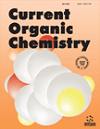- Home
- A-Z Publications
- Current Organic Chemistry
- Previous Issues
- Volume 26, Issue 7, 2022
Current Organic Chemistry - Volume 26, Issue 7, 2022
Volume 26, Issue 7, 2022
-
-
Application of Aromatic Substituted 2,2,2-Trifluoro Diazoethanes in Organic Reactions
More LessBy Cai ZhangThis review provides an overview of metal-, nonmetal-, light-, or catalyst freepromoting reactions of aromatic substituted 2,2,2-trifluoro diazoethanes with organic molecules for the synthesis of trifluoromethyl-substituted compounds. Several approaches will be reviewed and divided into (i) copper-, iron-, Trop(BF4)-, B(C6F5)3-, light-, or rhodiumpromoted reactions of aromatic substituted 2,2,2-trifluoro diazoethanes with silanes, amines, mercaptans, phosphonates, p-cyanophenol, benzoic acid, diphenylphosphinic acid, boranes and nBu3SnH, (ii) rhodium-catalyzed reactions of aromatic substituted 2,2,2-trifluoro diazoethanes with amides and phenylhydroxylamine, (iii) copper-, rhodium-, silver-, and lightcatalyzed reactions of aromatic substituted 2,2,2-trifluoro diazoethanes with alkynes, (iv) palladium-, copper-, rhodium- and iron-catalyzed reactions of aromatic substituted 2,2,2-trifluoro diazoethanes with alkenes, (v) BF3·OEt2-, copper-, tin- or TBAB-catalyzed reactions of aromatic substituted 2,2,2- trifluoro diazoethanes with HF·Py, (difluoroiodo)toluene (p-TolIF2), TMSCF3, AgSCF3, TMSCF2Br or 1,3- dicarbonyl compounds, (vi) palladium-, copper-, gold/silver- or rhodium-catalyzed reactions of aromatic substituted 2,2,2-trifluoro diazoethanes with indoles, benzene compounds or pyridines, and (vii) palladium-catalyzed reaction of aromatic substituted 2,2,2-trifluoro diazoethanes with benzyl or allyl bromides.
-
-
-
Role of Indole Derivatives in Agrochemistry: Synthesis and Future Insights
More LessAuthors: Manisha Rani, Divya Utreja and Shivali SharmaHeterocycles constitute a wider class of organic compounds which contribute significantly to every facet of pure and applied chemistry. Indole, one of the bicyclic heterocyclic compounds containing nitrogen atom, witnessed unparalleled biological activity such as antiviral, antibacterial, anticancer, anti-depressant and antifungal activities. Different biological activities exhibited by indole derivatives provide the impulsion to explore its activity against anti-phytopathogenic microbes to save the plants from pests and disease, as food security will once again become a rigid demand. This review mainly focuses on various methods related to the synthesis of indole derivatives and its role in agriculture.
-
-
-
Synthesis of Benzalacetophenone-based Isoxazoline and Isoxazole Derivatives
More LessAuthors: Saba Farooq and Zainab NgainiThe demand for natural product-based drugs with less cost and efficient procedures has become a challenge for researchers. Benzalacetophenone is a natural product-based species that is modified into numerous heterocyclic compounds, including isoxazoline and isoxazole derivatives. The utility of isoxazoline and oxazole derivatives has been increased for the synthesis of new and effective chemical entities to serve medicinal chemistry in the past few years. Isoxazoline and isoxazole are fascinating classes of heterocyclic compounds, which belong to N and O-heterocycles, and are widely used as precursors for the development of drugs. This review highlights the recent work on the synthesis of mono and bis isoxazoline and isoxazole derivatives using stable benzalacetophenone and functionalization of isoxazoline and isoxazole, along with the prevailing biological properties.
-
-
-
Synthetic Utility of Aminomercapto[1,2,4]triazoles in the Preparation of Fused Triazoles
More LessAuthors: Sayed M. Riyadh, Tariq Z. Abolibda, Abdelwahed R. Sayed and Sobhi M. GomhaTriazoles and their fused derivatives are regarded as one of the most pharmacologically significant pillars due to their potent, broad, and numerous activities. This current review presents recent progress in the synthetic utility of 3-substituted-4-amino-5-mercapto[1,2,4]- triazoles as building blocks for a diverse range of fused [1,2,4]triazoles with pharmacological interest eg. pyrazolo-triazoles, triazolo-thiadiazoles, triazolo-triazoles, triazolo-thiadiazines, triazolo-triazines, triazolo-tetrazines, triazolo-thiadiazepines, and others. The biological activity of some triazoles and their fused derivatives are also presented. This suggests that triazoles can be particularly promising synthons in synthesis of functionalized heterocyclic compounds used in the design of novel, highly effective pharmaceuticals with a broad spectrum of bioresponses. All of these topics are drawn in this review from the period from 2000 to 2020.
-
-
-
Advancement of the Cleavage Methods of Carbohydrate-derived Isopropylidene and Cyclohexylidene Ketals
More LessAuthors: Shilpi Gupta, Anjali Sharma, Dhananjoy Mondal and Smritilekha BeraCarbohydrates, amino acids, and nucleosides, the fundamental building blocks of complex biomolecules in nature, are essential starting materials for the fabrication of natural and unnatural structural entities, which necessitate the masking and demasking of various functional groups with the utmost chemoselectivity, mildness, and efficiency to avoid unintended bond breaking and formation, as well as associated reactions. Ketals, benzylidene, methoxymethyl, p-methoxybenzyl, silyl ethers, trityl, tert-butyl carbamate, and other functional groups are widely used in modern organic synthesis. In carbohydrate chemistry, the commonly used protecting functionality of isopropylidene and cyclohexylidene ketals necessitates effective methods for selective cleavage. This review summarises different methods for deblocking isopropylidene and cyclohexylidene ketals using inorganic acids, Lewis acid, silica- supported inorganic acids, Amberlite-120 (H+) resin, phosphotungstic acid, Nafion-H, NaBArF4.2H2O, montmorillonite clay, Dowex 50W-X8, camphorsulphonic acid (CSA), ceric ammonium nitrate, molecular iodine, ionic liquids, zeolites and so on.
-
Volumes & issues
-
Volume 29 (2025)
-
Volume 28 (2024)
-
Volume 27 (2023)
-
Volume 26 (2022)
-
Volume 25 (2021)
-
Volume 24 (2020)
-
Volume 23 (2019)
-
Volume 22 (2018)
-
Volume 21 (2017)
-
Volume 20 (2016)
-
Volume 19 (2015)
-
Volume 18 (2014)
-
Volume 17 (2013)
-
Volume 16 (2012)
-
Volume 15 (2011)
-
Volume 14 (2010)
-
Volume 13 (2009)
-
Volume 12 (2008)
-
Volume 11 (2007)
-
Volume 10 (2006)
-
Volume 9 (2005)
-
Volume 8 (2004)
-
Volume 7 (2003)
-
Volume 6 (2002)
-
Volume 5 (2001)
-
Volume 4 (2000)
Most Read This Month


